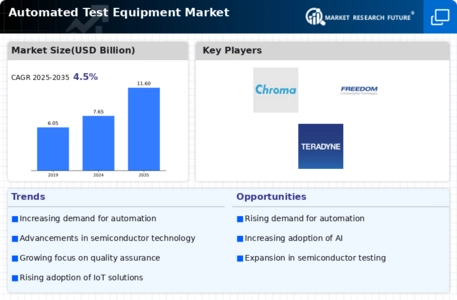Market Analysis
In-depth Analysis of Automated Test Equipment Market Industry Landscape
The automotive industry is undergoing a relentless phase of innovation, marked by advancements in quality, durability, and reliability. This rapid evolution necessitates testing experts to swiftly adapt to market changes, introducing new models that not only undergo cost-effective testing but also align with emerging technological shifts and regulatory requirements. In this landscape, Automated Test Equipment (ATE) emerges as a crucial tool, primarily employed to assess vehicle performance and conduct quality tests.
ATEs play a pivotal role in measuring various aspects, including engine wear, lubricant aeration, fuel dilution and evaporation, engine oil consumption, and the potential clogging of after-treatment systems. These testing tools contribute to evaluating critical parameters such as hand brake tension, engine oil consumption, and the intricate interplay between fuel and lubricant. By providing control over vehicle stability and enhancing riding comfort, these test equipment have become indispensable in the automotive sector.
The rising application of automated test equipment in the automotive industry is anticipated to be a significant driver for the global market during the forecast period. As automotive manufacturers strive for continuous improvement in vehicle performance and compliance with evolving industry standards, the demand for advanced testing solutions is on the rise.
Beyond the automotive sector, the utilization of test equipment spans a diverse range of industries, including electronics, telecommunications, and medical fields. One of the key advantages offered by automated functional testing is the substantial reduction in manufacturing time and cost. Industries across the spectrum are increasingly integrating fully automated test systems into their operations to enhance manufacturing quality and throughput.
Automated test equipment provides a myriad of benefits, including streamlined high-volume production, reduced test time, increased operational efficiency, and a decrease in the occurrence of measurement errors. These advantages collectively contribute to a more efficient manufacturing process, ultimately leading to significant cost savings. The implementation of automated test equipment is seen as a strategic move by industries aiming to optimize their manufacturing processes, ensuring product quality while minimizing both time and financial investments.
As a result, the reduced manufacturing time and cost facilitated by automated test equipment are poised to drive the growth of the global market throughout the forecast period. The shift toward automation reflects a broader trend in industries seeking innovative solutions to enhance their competitiveness, meet evolving demands, and ensure the overall efficiency of their manufacturing processes.










Leave a Comment